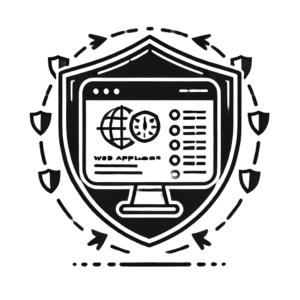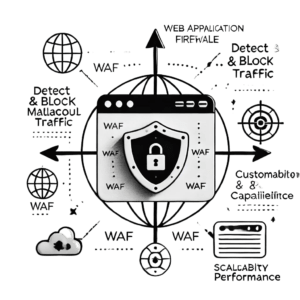Introduction to WAF and Its Importance

A Web Application Firewall (WAF) is a crucial security solution designed to protect web applications from various cyber threats and attacks. It acts as a barrier between your website and the internet, filtering and monitoring HTTP traffic to and from a web application. By analyzing and inspecting incoming traffic, it can detect and block malicious requests, such as SQL injection, cross-site scripting (XSS), and other common web application vulnerabilities. They can also help prevent data breaches, unauthorized access, and other security incidents that could compromise the integrity and confidentiality of your website.
Implementing it as part of your cybersecurity strategy is essential in today’s digital landscape where cyber threats are constantly evolving.
The Importance of Having a WAF
In the digital age, cybersecurity threats continue to evolve, making it essential for websites to have robust defenses in place. It is a crucial component in safeguarding your website from various online attacks. WAF acts as a barrier between your website and malicious actors, filtering out malicious traffic and protecting your web applications from common vulnerabilities such as SQL injection, cross-site scripting, and DDoS attacks.
One of the key reasons why your website needs a WAF is to ensure data confidentiality and integrity. By monitoring and filtering incoming traffic, it helps prevent unauthorized access to sensitive information and maintains the integrity of your data. Additionally, it enhances your website’s performance by optimizing web traffic and reducing the risk of downtime caused by cyberattacks.
Furthermore, implementing a WAF is crucial for maintaining compliance with industry regulations and standards. Many regulatory frameworks, such as PCI DSS and GDPR, require organizations to have adequate cybersecurity measures in place, including the use of WAF to protect customer data.
Overall, investing in a WAF is not just about protecting your website from cyber threats but also about safeguarding your reputation, ensuring customer trust, and staying ahead in an increasingly hostile online landscape.
How WAF Ensures Your Website Security
Web Application Firewall serves as a vital shield protecting your website from a myriad of cyber threats. As cyber attacks become increasingly complex, having a robust WAF in place is more crucial than ever. It works as a filter between your website server and incoming traffic, analyzing each data packet for potential threats and blocking malicious activities in real-time. It is designed to safeguard against common cyber threats such as SQL injection, cross-site scripting (XSS), DDoS attacks, and more.
One of the key advantages of WAF is its ability to detect and prevent attacks before they reach your web application, thereby minimizing the risk of data breaches and downtime. By continuously monitoring and filtering incoming traffic, it acts as a proactive defense mechanism, offering protection against both known and emerging threats. Implementing a WAF not only enhances your website’s security posture but also boosts customer trust and confidence in your online platform.
How It Protects Your Data
Web Application Firewall is a crucial security component that acts as a barrier between your website and potential cyber threats. It works by monitoring and filtering HTTP requests to and from a web application to protect it from various attacks such as cross-site scripting, SQL injection, and DDoS attacks. By analyzing incoming traffic and blocking malicious requests, it helps safeguard your sensitive data from unauthorized access and potential breaches.
One of the key benefits of using a WAF is its ability to defend against emerging threats in real-time. As cyber threats continue to evolve, having it in place can help ensure that your website stays protected and your data remains secure. Additionally, it provides detailed security logs and alerts, allowing you to monitor and respond to potential security incidents promptly.
Choosing the Right Solution for Your Website
Key Characteristics to Consider
A Web Application Firewall is an essential cybersecurity tool that acts as a barrier between your website and the internet, protecting it from various online threats. When selecting a WAF for your website, there are key characteristics to consider to ensure optimal protection.
First and foremost, consider the ability to effectively detect and block malicious traffic. Look for features such as advanced traffic filtering mechanisms, signature-based detection, and real-time threat intelligence feeds to enhance your website’s security posture.
Secondly, evaluate its customization capabilities. A flexible WAF that allows you to create custom rules and policies tailored to your website’s specific requirements is crucial for maximizing protection while minimizing false positives.
Furthermore, assess its scalability and performance metrics. A robust WAF should be able to handle high traffic volumes without compromising on speed or website performance.
In conclusion, choosing the right WAF with these key characteristics can significantly enhance your website’s security defenses and safeguard it from evolving cyber threats.
Best WAFs in the Market
WAF is a crucial security measure that helps protect websites from various online threats, such as SQL injection, cross-site scripting, and other forms of cyber attacks. By analyzing and filtering HTTP traffic between a web application and the internet, it can prevent malicious traffic from reaching the website, thus safeguarding sensitive data and ensuring a smooth user experience.
Investing in a reliable solution is essential for any website owner looking to enhance their cybersecurity posture. Not only does it act as a barrier against potential cyber threats, but it also helps comply with industry regulations and boost customer trust. With cyber attacks becoming more sophisticated and prevalent, having a robust WAF in place is no longer optional but a necessity.
When it comes to choosing the best solution for your website, there are several top-tier options available in the market. Leading solutions such as Imperva SecureSphere, Cloudflare WAF, and Akamai Kona Site Defender offer comprehensive protection, real-time threat intelligence, and advanced customization features to suit various business needs.
Monitoring and Maintenance of Your WAF
A Web Application Firewall serves as a critical security measure for protecting your website from various online threats, such as SQL injection, cross-site scripting, and other malicious attacks. Implementing a WAF is essential in today’s digital landscape where cyber attacks are becoming more sophisticated and prevalent. However, simply having it installed is not enough; regular monitoring is equally crucial to ensure its effectiveness.
Regular monitoring involves actively checking and analyzing the traffic that passes through the firewall. By monitoring the logs and alerts, you can detect any unusual patterns or suspicious activities in real-time. This proactive approach enables you to promptly identify and respond to potential security incidents before they escalate, thus minimizing the risk of a successful cyber attack on your website.
Furthermore, regular monitoring allows you to fine-tune your security policies and configurations based on the evolving threat landscape. By analyzing the monitoring data, you can optimize your settings to better protect your website against emerging threats and vulnerabilities. Ultimately, consistent monitoring of your WAF is essential for maintaining the security and integrity of your online presence in today’s increasingly hostile cyber environment.
Tips for Effective WAF Maintenance
In today’s digital landscape, a WAF is a crucial component in safeguarding your website from various cyber threats. It serves as a protective barrier between your website and malicious actors, filtering out potentially harmful traffic and ensuring the security of your web applications. To ensure that your WAF functions optimally, it is essential to prioritize regular maintenance and monitoring.
Here are some tips for effective maintenance:
- Regularly update its rule set to protect against the latest threats and vulnerabilities
- Monitor the performance to identify any potential issues or anomalies that may indicate a security breach
- Configure logging and reporting features to track and analyze traffic patterns, helping you detect and respond to security incidents swiftly
- Conduct regular security audits to assess the effectiveness of your configuration and policies.
- Train your team on its best practices and ensure they are familiar with the security policies in place
By following these tips and prioritizing the maintenance of your WAF, you can enhance the overall security posture of your website and protect it from evolving cyber threats.
